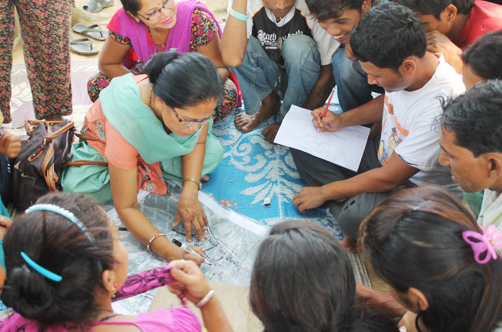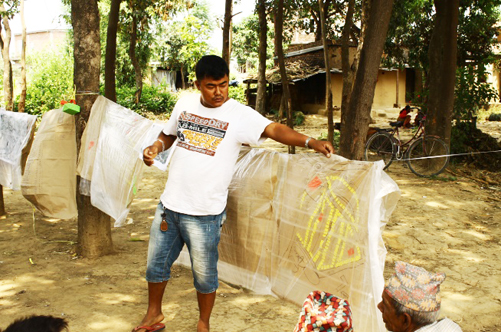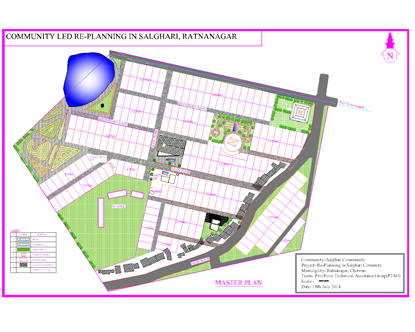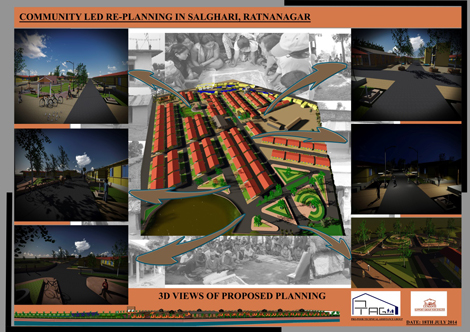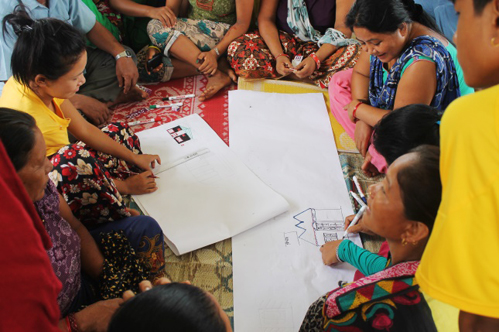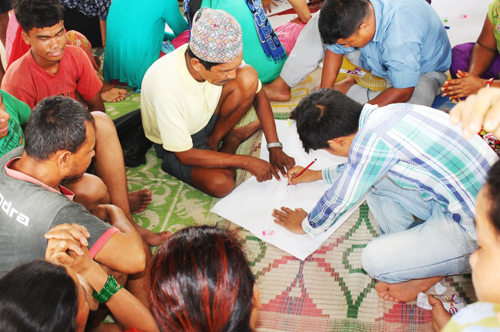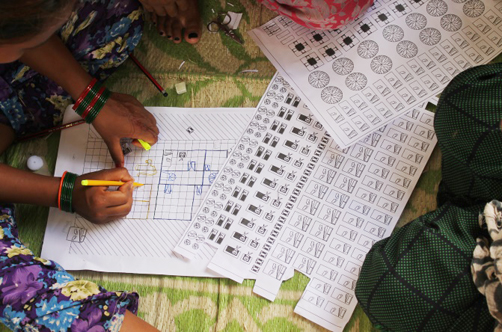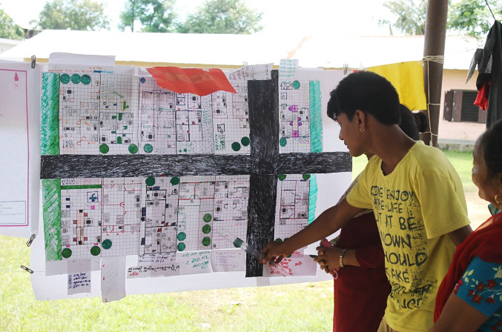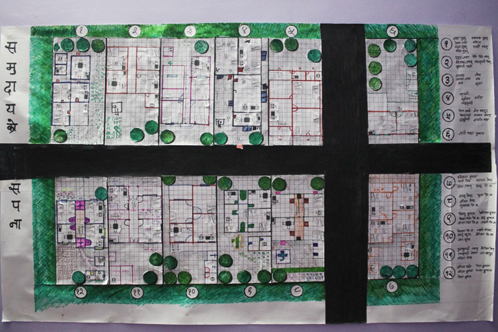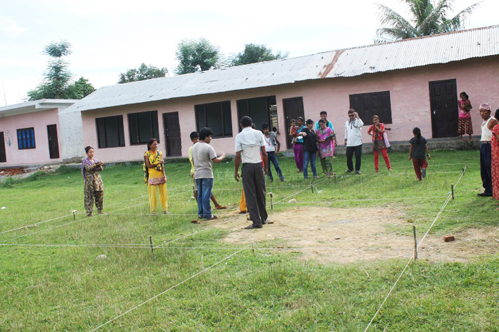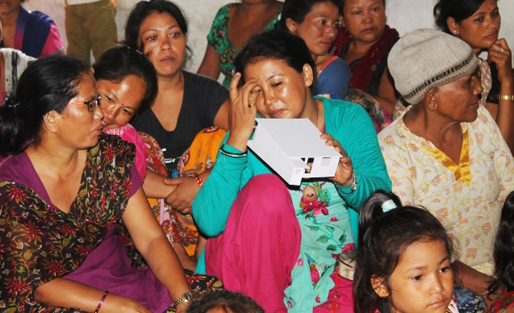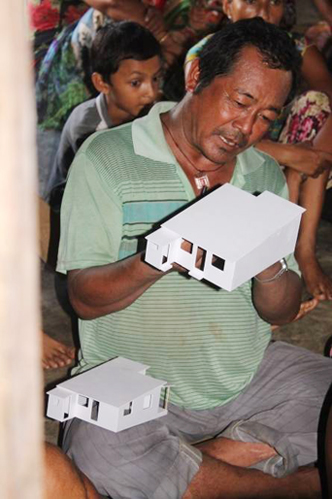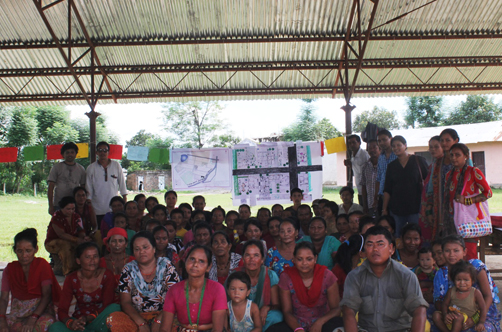Perween Rahman Fellowship
Community re-planning for land security negotiation
Mr. Parvesh Khanal and Mr. Tulsi Kumar Kaway, Community Architects from PTAG, worked with the Salghari forest community to prepare housing and settlement upgrading plans and train local builders to negotiate for an alternative site plan in ACCA PMC.
1. Background
Urbanization rate in the cities of Nepal is nearly 7% annually with increased number of people living in informal and squatter settlements. Recent data show that about 10% of the total city population lives in these types of settlements in extremely poor living conditions in these cities. And also, in the Ratnanagar Municipality is not able to deal with problems and issues related with the squatter communities single handedly.
The ACCA program initiated in the city of Ratnanagar in 2011, targeting Salghari Community with 190 households and population of 1334 is living in insecure land with most encroaching forest lands and wetlands since more than 40 years in a very vulnerable condition, Whereas;
1. The communities in the city are proactive and are eager to move beyond their poverty-ridden and deprived lives.
2. Local municipality is enthusiastic to partner with the communities to resolve the problems related with these informal settlements.
3. Squatter federations in the city (Nepal Sukumbasi Sudhar Samiti NSSS) are actively involved in raising issues of the squatter up to the policy level.
Thus, an urgent need was felt to develop a program that focus on addressing the issues of shelter and land in a holistic way. Hence, in collaboration with Lumanti, Support Group for Shelter and Ratnanangar Municipality, a project was initiated with community people as the key actors, targeting Salghari community in Ratnanagar.
2. Objective
To strengthen the community organizations, build their saving and get linked with various stake holders such as the municipality. The small scale projects became a way to link all the poor communities. Inter community exchanges and sharing became away to build this and the other cities learnt from them.
3. Process
3.1 Community Design Workshop
More than 3 months later, the implementation of the project is not taking its pace due to some changes in key personnel’s of Municipality. Not to let the hope down of the community we are continuing different programs such as house hold survey, to identify the financial conditions and forming saving groups to manage the fund, Land survey for the implementation. Regular meeting with the communities to bring about some positive changes within the community has been one of the key activities. Regular follow-up and meetings with the municipality are being organized in order to get a written commitment as promised by the political parties and municipality from their side for not displacing the families after the new settlement is developed.
1. Background
Urbanization rate in the cities of Nepal is nearly 7% annually with increased number of people living in informal and squatter settlements. Recent data show that about 10% of the total city population lives in these types of settlements in extremely poor living conditions in these cities. And also, in the Ratnanagar Municipality is not able to deal with problems and issues related with the squatter communities single handedly.
The ACCA program initiated in the city of Ratnanagar in 2011, targeting Salghari Community with 190 households and population of 1334 is living in insecure land with most encroaching forest lands and wetlands since more than 40 years in a very vulnerable condition, Whereas;
1. The communities in the city are proactive and are eager to move beyond their poverty-ridden and deprived lives.
2. Local municipality is enthusiastic to partner with the communities to resolve the problems related with these informal settlements.
3. Squatter federations in the city (Nepal Sukumbasi Sudhar Samiti NSSS) are actively involved in raising issues of the squatter up to the policy level.
Thus, an urgent need was felt to develop a program that focus on addressing the issues of shelter and land in a holistic way. Hence, in collaboration with Lumanti, Support Group for Shelter and Ratnanangar Municipality, a project was initiated with community people as the key actors, targeting Salghari community in Ratnanagar.
2. Objective
To strengthen the community organizations, build their saving and get linked with various stake holders such as the municipality. The small scale projects became a way to link all the poor communities. Inter community exchanges and sharing became away to build this and the other cities learnt from them.
3. Process
3.1 Community Design Workshop
- The community members were involved understanding the site, analyzing the constraints and problem faced, and discussed for the solution listing them out.
- The problem of the community were divided into 3 groups as the Toles i.e. Dafe Munal Tole, Pargatisil Tole, Nawajagrati Tole. Each Toles were designed by the community, which were divided into small groups.
- The community drew the existing condition of the site with the help of Google maps provides by architects.
- Each group was required to design the re-plan of whole community with facilitation of technical person, addressing the problems they had listed.
- Each group shared their design that they have planned.
- Youngsters from the community worked together with the architects to get the necessary measurement required to draw out the existing settlement, and land distribution.
- Sharing the process, which Salghari community applied, among Ratnanagar Municipality, federations, and political parties to develop the design of the community, and discussing about the most appropriate the land distribution.
- Sharing the final design with conceptual 3d animation of the community, which was designed by the community themselves in previous workshop. The community seems mesmerized.
- The community members were given homework to design their dream house freely based on their status and requirement.
- Sharing of the homework.
- According to their requirements, the community members were divided into 6 groups and with technical assistance they were asked to design their same dream being constraint on the plot (23x46 sq. ft.) as agreed during first phase.
- The final concept of the project was derived based on the ideas of the community members. This was an extremely participatory process.
More than 3 months later, the implementation of the project is not taking its pace due to some changes in key personnel’s of Municipality. Not to let the hope down of the community we are continuing different programs such as house hold survey, to identify the financial conditions and forming saving groups to manage the fund, Land survey for the implementation. Regular meeting with the communities to bring about some positive changes within the community has been one of the key activities. Regular follow-up and meetings with the municipality are being organized in order to get a written commitment as promised by the political parties and municipality from their side for not displacing the families after the new settlement is developed.
Name of Fellow:
Mr. Parvesh Khanal and Mr. Tulsi Kumar Kaway
Organization:
Lumanti Support Group for Shelter and Ratnanangar Municipality
Country:
Nepal

